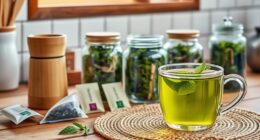To store and freeze coffee beans effectively, keep them in cool, dark, and dry places. Use airtight containers, like glass or stainless steel, to protect against oxygen and moisture. Avoid plastic, which can retain odors. For long-term storage, freeze whole beans in vacuum-sealed bags at 0°F (-18°C). Thaw them gradually to preserve flavor. Always label containers with dates and avoid repeatedly freezing and thawing. Watch out for signs of stale coffee, such as a flat taste or oily surface. For more expert tips and tricks on maintaining your coffee's freshness, keep exploring this guide!
Key Takeaways
- Store coffee beans in cool, dark, and dry areas to maximize freshness and prevent spoilage.
- Use airtight containers like glass or stainless steel to limit oxygen exposure and maintain flavor quality.
- Freeze whole, freshly roasted beans in vacuum-sealed bags or airtight containers for long-term preservation without flavor loss.
- Label frozen beans with dates and avoid repeated thawing to ensure optimal freshness when ready to use.
- Regularly check for signs of staleness, such as diminished aroma and dull appearance, to ensure quality coffee.
Ideal Containers for Coffee

When it comes to storing coffee beans, choosing the right container is essential for preserving freshness and flavor. There are various coffee storage solutions available, from airtight containers to vacuum-sealed bags. The key is to keep the beans away from light, air, heat, and moisture, as these elements can compromise the flavor. Additionally, choosing a container with a one-way valve to release the gases produced by the beans is also important for maintaining freshness. By investing in the right coffee storage solutions, you can ensure that your beans stay fresh and flavorful for as long as possible.
Opt for materials like glass or ceramic, as they prevent flavor contamination. Stainless steel is also a great choice for its durability and airtight seals. Remember that air exposure can quickly diminish coffee's taste, so ensure your container is truly airtight.
Steer clear of plastic, which can retain odors and often lacks airtightness. Look for containers with features like vacuum seal technology to remove oxygen, one-way valves for CO2 escape, and silicone-ringed lids for a tight seal.
Recommended options include the Fellow Atmos Vacuum Coffee Canister and the Airscape Coffee Storage Container, both designed to keep your beans fresh.
Remember to choose opaque or tinted containers to block out light and maintain quality.
Short-Term Storage Locations

To keep your coffee beans fresh in the short term, select storage locations that offer cool, dark, and stable environments. Avoid placing them near heat sources like stovetops, ovens, or heating vents, and steer clear of direct sunlight to maintain optimal conditions.
A pantry or cupboard works well; just be sure to use opaque containers to block light. For best results, keep humidity levels between 50% and 60%, avoiding basements or bathrooms where moisture can build up. Additionally, airtight containers are essential to prevent air entry, which can compromise the beans' flavor.
Also, ensure your storage area is free from strong odors by keeping your coffee away from spices and cleaning products. Label your containers with roast dates for easy tracking.
Following these guidelines will help preserve your coffee's flavor and freshness.
Long-Term Storage Solutions

While you may enjoy your coffee fresh, storing it properly for the long term is crucial for maintaining its flavor and quality.
Use heavy-duty, airtight containers made from stainless steel or dark glass to keep your beans safe. For ground coffee, #10 cans can preserve freshness for over ten years. Mylar bags with oxygen absorbers are excellent for both ground and green beans, while vacuum-sealed bags provide extra protection in the freezer. Additionally, green beans can last practically forever when stored correctly.
Avoid transparent containers, as light compromises flavor. Ideally, store your coffee in a cool, dark place, away from heat sources. If you can't freeze, ensure a consistent temperature and keep the area dry to prevent moisture.
Proper storage is the key to enjoying your coffee long-term.
Best Practices for Freezing

Freezing coffee beans can be a great way to preserve their freshness and flavor, especially if you buy in bulk. Start by choosing high-quality, freshly roasted beans, and always check the roasting date.
Keep the beans whole to maintain their flavor longer; don't grind them before freezing. Use airtight containers like glass jars with rubber seals or vacuum-sealed bags to eliminate air exposure. Additionally, freezing can help extend shelf life by slowing down the aging processes that diminish flavor.
Store your beans in the coldest part of the freezer at a constant 0°F (-18°C). Avoid strong odors that could taint their flavor.
When you're ready to use them, thaw the beans gradually and only take out what you need. Remember to label and date your beans to keep track of freshness.
Freezing Techniques for Freshness

When you want to keep your coffee beans tasting fresh, employing effective freezing techniques is essential.
Start by freezing whole coffee beans instead of ground ones, as this reduces exposure to oxygen. You can use the original packaging if it's vacuum-sealed or has a one-way degassing valve.
Alternatively, consider portioning your beans into resealable bags, removing as much air as possible before freezing. For convenience and eco-friendliness, single dose tubes maintain freshness and ensure precise servings. Additionally, make sure to store your beans in a cool, dark place before freezing to further protect them from light and heat.
Make sure to use airtight, moisture-resistant packaging to prevent freezer burn.
Lastly, remember that beans can stay frozen for up to 3 to 6 months, so plan your portions wisely to enjoy optimal flavor.
Common Storage Mistakes

Many coffee enthusiasts unknowingly make common storage mistakes that compromise the quality of their beans.
Using clear containers lets light in, causing rapid oxidation and a stale flavor. Retail packaging often lacks airtight seals, allowing oxygen to spoil your coffee. Additionally, maintaining a consistent temperature is vital for preserving the flavor and aroma of your beans.
Storing beans in the refrigerator or freezer might seem smart, but it exposes them to moisture and unwanted odors, ruining their taste.
Avoid placing your coffee in direct sunlight or near heat sources, as this degrades flavor and aroma.
Lastly, remember that coffee absorbs surrounding odors and is sensitive to humidity. Keeping your beans in a stable, cool, and dark environment will help maintain their freshness and ensure a delightful cup every time.
Maintaining Optimal Flavor

To enjoy the full spectrum of flavors in your coffee, maintaining optimal storage conditions is key.
Store your coffee beans in an opaque, airtight container to shield them from light and air. Keep this container at room temperature, away from ovens, stovetops, and direct sunlight, ideally between 50°F and 70°F (10°C to 21°C). Additionally, remember that coffee beans' enemies are air, moisture, heat, and light, so protecting them from these elements is crucial for preserving their flavor.
Avoid areas with temperature fluctuations and high moisture levels, as these can compromise flavor. Choose a container with a secure seal, steering clear of original packaging that often lacks airtight properties.
If you're freezing beans, do so at around ten days post-roast in a truly airtight container. Remember to remove only what you need, keeping the rest sealed to maintain freshness.
Tips for Labeling and Organization

Properly labeling and organizing your coffee beans not only enhances your brewing experience but also helps you maintain their freshness.
Start by marking each container with the roasting date, storage date, and purchase date. Include the type of bean, like Arabica or Robusta, and any batch numbers if applicable. Additionally, whole beans can last up to a month when stored correctly, making proper organization even more critical.
Store different beans separately to avoid flavor mixing, and keep frequently used ones in easy-to-reach spots. Remember the first-in, first-out principle: use older beans before newer ones, and regularly rotate your stock based on storage dates.
For optimal conditions, place containers in cool, dark, and dry areas, away from sunlight and moisture. This approach ensures your coffee remains fresh and flavorful whenever you brew.
Frequently Asked Questions
Can I Store Coffee Beans in the Refrigerator?
You shouldn't store coffee beans in the refrigerator.
The fridge can introduce unwanted moisture and odors that compromise the beans' flavor and aroma.
Condensation and temperature fluctuations can lead to faster degradation, making your coffee taste stale.
Instead, keep your beans in a cool, dark place, using an airtight container to protect them from light and air.
This way, you'll enjoy a fresher, more flavorful cup every time you brew.
How Long Do Coffee Beans Last After Opening?
After you open your coffee beans, they stay fresh for about a week if you store them properly in a cool, dark place.
Beyond that, the flavor and aroma start to fade. You can still use them for up to three weeks, but expect some loss in quality.
To maintain freshness, keep them in an airtight container and avoid exposing them to light, heat, and strong odors.
Is It Safe to Re-Freeze Coffee Beans?
Yes, it's safe to re-freeze coffee beans. Unlike soft foods, they won't suffer physical damage from re-freezing.
However, you might notice slight flavor degradation due to temperature changes.
To keep your beans fresh, store them in truly airtight containers and divide them into smaller portions.
This way, you can quickly return unused beans to the freezer and minimize exposure to moisture and odors, preserving their quality for your next brew.
Does Grinding Coffee Beans Affect Storage Life?
Yes, grinding coffee beans definitely affects their storage life.
When you grind beans, you expose more surface area to air, causing them to stale faster. Ground coffee can lose its flavor and aroma within just a few days, while whole beans can stay fresh for weeks if stored properly.
To enjoy the best taste, it's best to grind your beans just before brewing rather than pre-grind and store them for later use.
What Are Signs That Coffee Beans Have Gone Bad?
If you're wondering about signs that coffee beans have gone bad, pay attention to their smell and appearance. A musty or rancid odor indicates spoilage.
Visually, look for mold, discoloration, or an oily sheen. Texture-wise, beans should feel crisp; if they're sticky or soft, they're likely spoiled.
Finally, if your coffee tastes flat or bitter instead of rich and aromatic, it's time to toss those beans and get fresh ones!
Conclusion
By following these storage tips, you can keep your coffee beans fresh and flavorful for longer. Remember to choose the right containers and locations, and don't skimp on freezing techniques if you want to preserve that rich taste. Avoid common mistakes and stay organized with labeling to ensure you always grab the best beans. With just a little effort, you'll enjoy every cup of coffee just as it was meant to be—delicious and aromatic!










